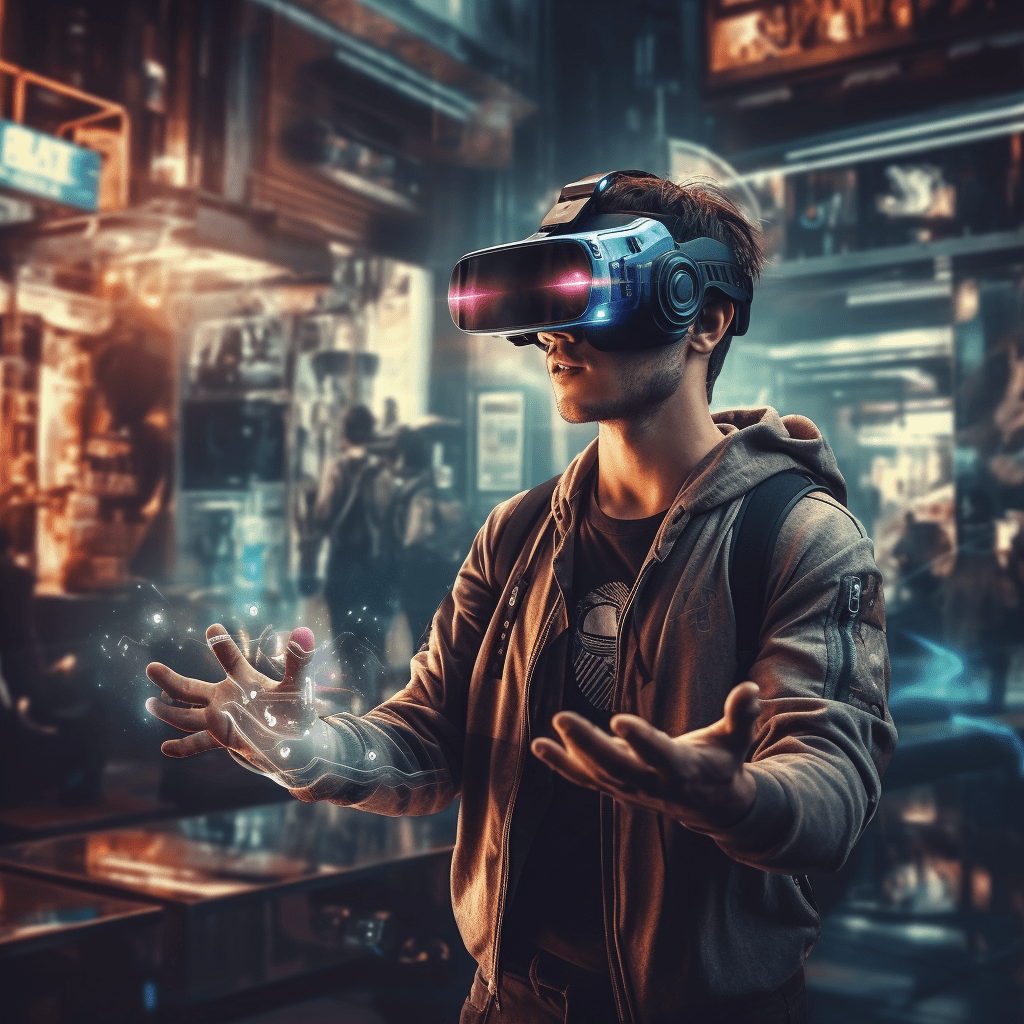Introduction
Augmented reality gaming, also known as AR gaming, is a form of gaming that combines virtual elements with the real world. It involves overlaying digital content onto the physical environment, allowing players to interact with virtual objects and characters in real-time. The current state of augmented reality gaming is rapidly evolving, with advancements in technology opening up new possibilities for immersive and interactive gameplay. This article will explore the opportunities that augmented reality gaming presents for the future.
Advancements in Technology
Enhancing AR Gaming Through Technology
Technological advancements have played a significant role in improving augmented reality gaming. The development of more powerful smartphones and tablets, as well as the introduction of wearable devices such as smart glasses, has enhanced the capabilities of AR gaming. These advancements have allowed for more realistic graphics, smoother gameplay, and improved tracking of virtual objects in the real world.
Improved hardware has also had a significant impact on the gaming experience. High-resolution displays and faster processors have made it possible to create more detailed and immersive virtual worlds. Additionally, advancements in camera technology and sensors have improved the accuracy and responsiveness of augmented reality experiences.
Examples of innovative technologies that have enhanced augmented reality gaming include Apple’s ARKit and Google’s ARCore. These software development kits (SDKs) provide developers with tools to create AR experiences for iOS and Android devices, respectively. They enable features such as motion tracking, environmental understanding, and light estimation, which enhance the realism and interactivity of AR games.
Immersive Gaming Experience
Immersive AR Gaming: Beyond the Screen
One of the key advantages of augmented reality gaming is its ability to provide a more immersive experience compared to traditional gaming. By overlaying virtual elements onto the real world, AR games create a sense of presence and interaction that goes beyond what can be achieved with a screen-based game.
Virtual reality (VR) also plays a role in enhancing immersion in augmented reality gaming. VR headsets can be used in conjunction with AR technology to create a more immersive visual experience. By blocking out the real world and replacing it with a virtual environment, VR headsets can transport players to entirely new worlds and enhance the sense of presence in AR games.
Popular augmented reality games such as Pokémon Go and Harry Potter: Wizards Unite offer immersive gameplay by blending the virtual and real worlds. Players can explore their surroundings, discover virtual creatures or objects, and engage in interactive gameplay that seamlessly integrates with their environment.
Integration with Real-World Environments
AR Gaming Meets the Real World
Augmented reality gaming seamlessly integrates with real-world environments, allowing players to interact with virtual objects and characters in familiar surroundings. This integration opens up a world of possibilities for location-based augmented reality games.
Location-based AR games use GPS and other location-tracking technologies to create gameplay experiences that are tied to specific real-world locations. Players can explore their surroundings, discover hidden treasures, and engage in location-specific challenges. This integration with real-world environments adds a layer of excitement and discovery to the gaming experience.
Successful examples of location-based augmented reality games include Ingress and Jurassic World Alive. Ingress, developed by Niantic, the creators of Pokémon Go, allows players to capture and control virtual portals located at real-world landmarks. Jurassic World Alive, inspired by the Jurassic Park franchise, lets players collect and interact with virtual dinosaurs in their own neighborhoods.
Social Interaction and Collaboration
Connecting Through AR Gaming
Augmented reality gaming promotes social interaction and collaboration by allowing players to connect and play together in real-time. Multiplayer AR games enable players to team up, compete against each other, or work together to achieve common goals.
The social aspect of augmented reality gaming can strengthen social connections and foster teamwork. Players can meet up in real life to play together, or they can connect virtually and interact with each other’s avatars in the game. This social interaction adds a new dimension to the gaming experience and can lead to the formation of new friendships and communities.
Examples of augmented reality games that encourage teamwork and collaboration include Ghostbusters World and The Walking Dead: Our World. These games allow players to team up with friends or other players to battle virtual ghosts or zombies in their own neighborhoods. By working together, players can overcome challenges and achieve higher levels of success.
Educational Opportunities
AR Gaming for Learning
Augmented reality gaming has the potential to be used for educational purposes, offering a new way to enhance learning experiences. By overlaying educational content onto the real world, AR games can make learning more interactive and engaging.
AR games can be designed to teach various subjects, such as history, science, or geography. Players can explore historical landmarks, interact with virtual scientific experiments, or discover geographical features in their own surroundings. This hands-on approach to learning can improve retention and understanding of educational concepts.
Examples of educational augmented reality games include AnatomyAR+ and World Brush. AnatomyAR+ allows users to explore and interact with virtual human anatomy models, providing a unique learning experience for medical students and professionals. World Brush allows users to create and share virtual artwork in the real world, fostering creativity and artistic expression.

Health and Fitness Benefits
AR Gaming for a Healthier Lifestyle
Augmented reality gaming can promote physical activity and fitness by encouraging players to move and explore their surroundings. Unlike traditional screen-based gaming, AR games require players to be physically active and engage with the real world.
AR games can incorporate exercise challenges, such as walking or running a certain distance, to progress in the game. This gamification of physical activity can motivate players to be more active and lead to improved health and fitness outcomes.
Examples of augmented reality games that promote health and fitness include Zombies, Run! and Pokémon Go. Zombies, Run! is an immersive running game that combines storytelling and gameplay to motivate players to run and complete missions in a post-apocalyptic world. Pokémon Go encourages players to walk and explore their surroundings to capture virtual Pokémon creatures.
Business and Economic Opportunities
The Business Potential of AR Gaming
Augmented reality gaming has the potential to have a significant economic impact. As the technology continues to evolve and become more accessible, businesses have the opportunity to capitalize on the growing market for AR games.
Companies can develop and publish their own AR games, creating new revenue streams and attracting a wider audience. Additionally, businesses can partner with existing AR game developers to incorporate their products or services into the gameplay, creating opportunities for product placement and advertising.
Successful businesses in the augmented reality gaming industry include Niantic, the creators of Pokémon Go, and Magic Leap, a company that develops AR headsets. These companies have capitalized on the popularity of AR gaming and have achieved significant success in the market.
Ethical Considerations
Ethical Aspects of AR Gaming
As with any emerging technology, augmented reality gaming raises ethical considerations that need to be addressed. One of the main concerns is privacy and data security. AR games often require access to personal information and location data, which raises concerns about how this data is collected, stored, and used.
There have also been ethical issues surrounding the use of augmented reality in public spaces. For example, some players of Pokémon Go have been criticized for trespassing on private property or causing disturbances in public areas while playing the game. These issues highlight the need for responsible use of AR technology and consideration for the impact on others.
Conclusion
The Future of AR Gaming
Augmented reality gaming presents numerous opportunities for the future. Advancements in technology have improved the capabilities of AR gaming, providing a more immersive and interactive experience. The integration of AR with real-world environments opens up new possibilities for location-based gameplay. Social interaction and collaboration are enhanced in multiplayer AR games, fostering connections and teamwork. AR gaming also has educational, health, and fitness benefits, as well as economic opportunities for businesses. However, ethical considerations must be addressed to ensure responsible use of AR technology. With its potential for innovation and growth, the future of augmented reality gaming looks promising.
FAQ
Q1: What is augmented reality gaming?
A1: Augmented reality gaming combines virtual elements with the real world, allowing players to interact with virtual objects and characters in real-time.
Q2: How has technology improved augmented reality gaming?
A2: Technological advancements have led to more powerful devices and improved hardware, enabling more realistic graphics and smoother gameplay in AR games.
Q3: How does augmented reality gaming provide a more immersive experience?
A3: By overlaying virtual elements onto the real world, AR gaming creates a sense of presence and interaction that goes beyond traditional screen-based gaming.
Q4: Can augmented reality gaming be used for educational purposes?
A4: Yes, AR gaming can enhance learning experiences by overlaying educational content onto the real world, making learning more interactive and engaging.
Q5: What are the health and fitness benefits of augmented reality gaming?
A5: AR gaming promotes physical activity and fitness by encouraging players to move and explore their surroundings, leading to improved health outcomes.
Q6: Are there business opportunities in augmented reality gaming?
A6: Yes, businesses can develop their own AR games or partner with existing AR game developers to capitalize on the growing market for AR games.
Q7: What are some ethical considerations in augmented reality gaming?
A7: Ethical concerns in AR gaming include privacy and data security, as well as responsible use of AR technology in public spaces.
Q8: Can augmented reality gaming be used for educational purposes?
A8: Yes, AR gaming can enhance learning experiences by overlaying educational content onto the real world, making learning more interactive and engaging.
Q9: Are there health and fitness benefits associated with augmented reality gaming?
A9: Yes, AR gaming encourages physical activity and can lead to improved health and fitness outcomes.
Q10: How can businesses benefit from augmented reality gaming?
A10: Businesses can develop their own AR games or partner with existing AR game developers to create new revenue streams and attract a wider audience.







